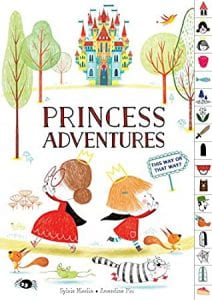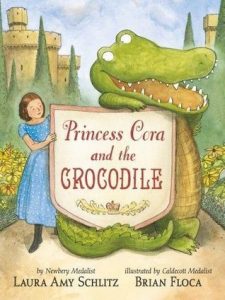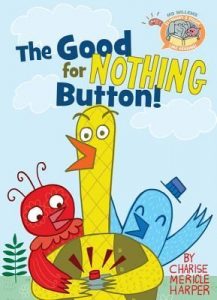 Misslin, Sylvie. Princess Adventures: This Way or That Way? Houghton Mifflin Harcourt, 2020. 978-0-358-04186-2. 32 p. Grades K-2.
Misslin, Sylvie. Princess Adventures: This Way or That Way? Houghton Mifflin Harcourt, 2020. 978-0-358-04186-2. 32 p. Grades K-2.
When Princesses Rose and Josephine set out for adventure, they cannot agree on which path to take, thus it is up to the reader to decide. A two sentence introduction to the plot is followed by a choice of two icons, one for each girl. These coordinate with tabs running vertically along the right edge of the page. At top is a castle which serves as a home tab followed by a picture of each princess then moving down to common items: flowers, a sword, a spiderweb, a window. Each item leads readers to a spread featuring a brief plot point in the tale. After selecting one of the girls to follow, readers use these tabs to turn to the next installment of the story until a happy ending or the return to castle prompt begins the story all over again. Depending on the reader’s interests, the princesses may stop for berries or a nap in the forest, encounter a fearsome dragon, or sample sweets baked by the royal chefs. While some choices are linear, parts of the story may require readers to return to earlier pages in the book or to skip ahead. Plots are brief but endearing and likely to be enjoyed by early readers while the interactive tabs will empower reluctant readers to take control of the story. Whimsical illustrations enhance the humorous fairytale theme. Princess Rose appears to be slightly older with brunette hair and glasses while Josephine’s hair is a reddish blonde. Both Princesses and all secondary human characters present as white with variations of blonde, brown and black hair.
THOUGHTS: This interactive picture book is sure to be a hit with the fairytale lovers and offers pre-readers a chance to practice storytelling and may incentivize reluctant readers to keep trying until one of two possible paths to a happy ending is revealed. Tabs are integral to the page, making it easy for readers to select their story path with minimal wear and tear. The story mechanic of selecting a plot line is intuitive but not explicitly explained to readers.
Picture Book/Moveable Jackie Fulton, Mt. Lebanon SD


